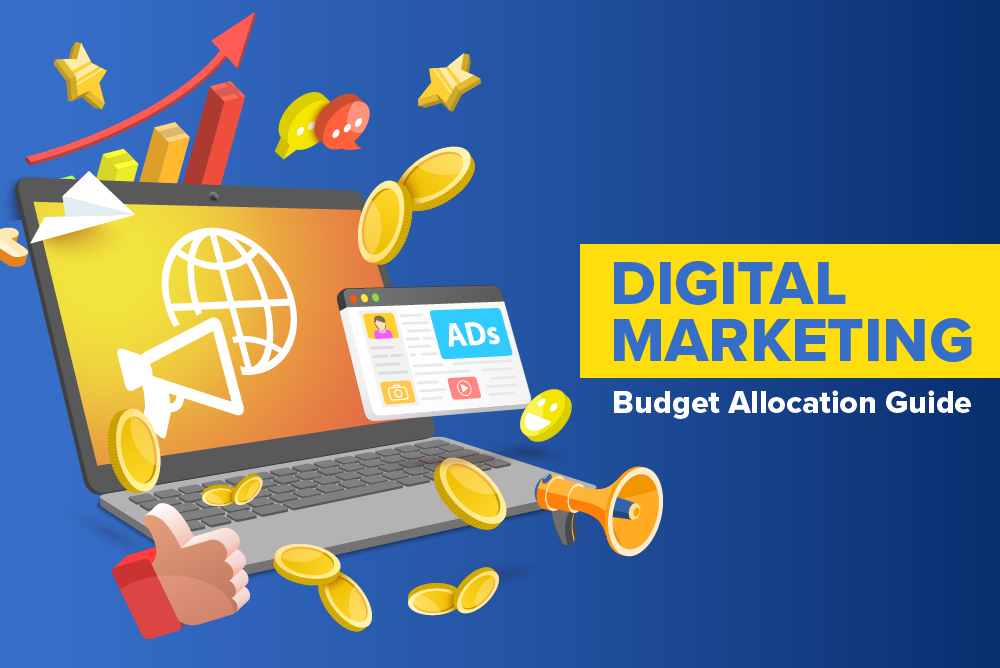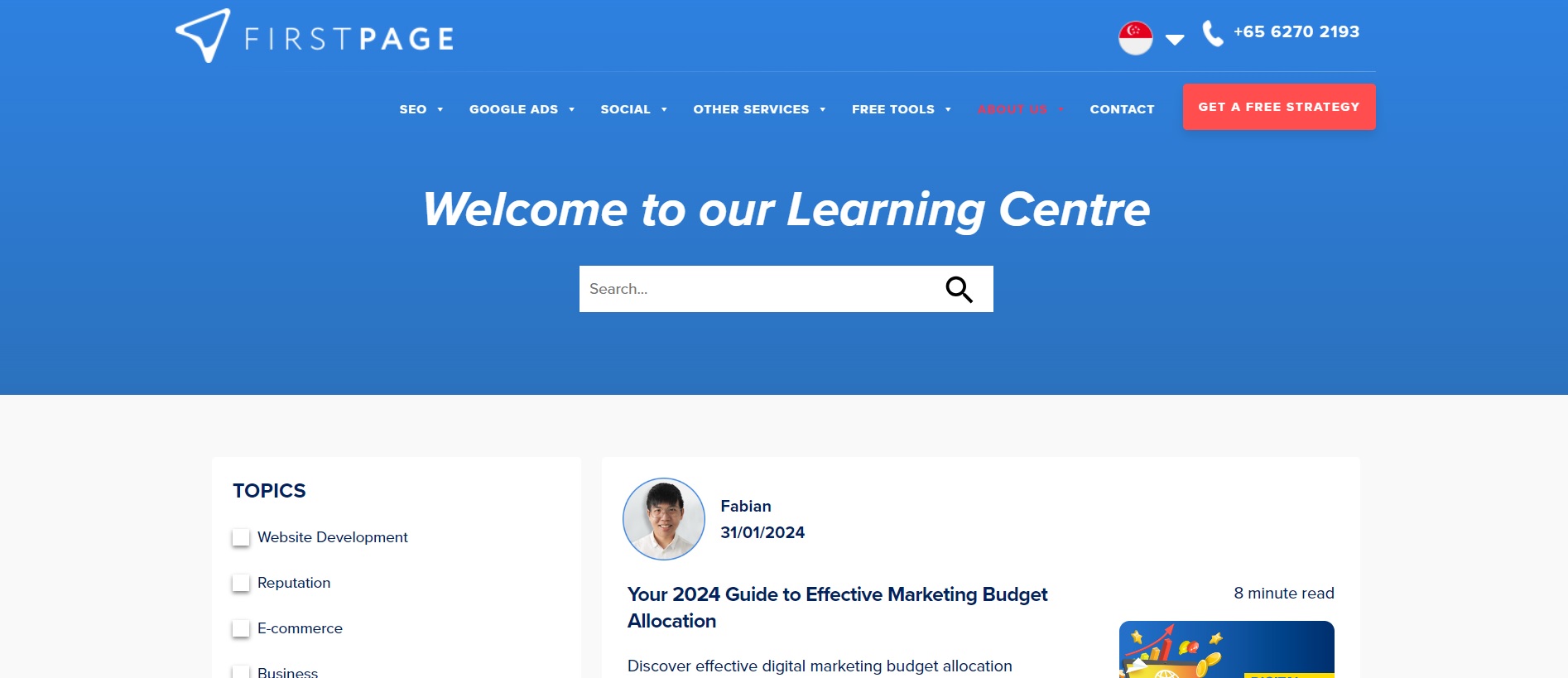In 2024, mastering the art of marketing budget allocation will be key to thriving in the increasingly competitive digital marketing landscape.
According to Gartner’s CMO’s Guide to Crafting a Marketing Budget, digital marketing’s share of overall marketing spend has plateaued at 56%, signalling tighter budgets and a greater need for investments that yield optimal ROI across customer awareness, consideration, conversion, and loyalty. Adding to the challenge, Harvard Business Review’s article “Making the Business Case for Your Marketing Budget” highlights how over 50% of CMOs face pressure to deliver immediate financial outcomes. Put simply, marketers in 2024 face the challenge of balancing short-term demands with long-term growth whilst on a smaller budget.
In this guide, we’ll explore what you need to consider for effective digital marketing budget allocation and how to create a marketing budget plan that will ensure your brand’s enduring success in 2024 and beyond.
How to Allocate Your Marketing Budget in 2024
Digital marketing is rarely standalone but part of an overall, broader marketing strategy. Deloitte’s 2022 CMO Survey highlighted that marketing budgets for most companies average about 11.8 percent of the overall budget. Other studies, like Magic Number’s research on marketing budgets, suggest that the sweet spot for ad spend is between five to ten percent of the company revenue.
With those ballpark percentages established, analytics software company Improvado’s blog on marketing budget allocation suggests the following framework for splitting your budget:
40-50%: Digital marketing for online engagement Goals
A significant portion of your marketing budget, 40-50%, should be dedicated to digital channels. This includes investments in SEO, paid advertising, and social media engagement. This allocation is especially useful for businesses aiming to increase their online presence, boost e-commerce sales, or engage with a digitally savvy audience.
20-30%: Traditional marketing for broad awareness
Traditional channels like print and broadcast media should account for 20-30% of your marketing budget. This is strategic for companies looking to enhance brand recognition across diverse demographics or to specific audience groups like the elderly, where traditional media has a strong presence.
10-20%: Events and sponsorships to enhance customer relationships
Allocating 10-20% of the marketing budget to events and sponsorships is vital for strategies focused on building direct customer relationships and enhancing brand loyalty. This is particularly relevant for businesses that benefit from in-person interactions, such as B2B companies or consumer brands with a significant physical presence.
5-10%: Research and analytics for data-driven decision-making
Lastly, allocating 5-10% of your marketing budget towards research and analytics can help you better understand market dynamics and consumer behaviour. This allocation is key for companies prioritising data-driven marketing strategies and looking to refine their campaigns based on actionable insights.
Tailoring your marketing budget to business needs
While frameworks like Improvado’s offer a valuable starting point, your marketing budget allocation strategy should be customised to your company’s industry, size, competitive landscape and objectives.
For instance, a tech startup may benefit from a larger digital marketing budget to fuel rapid online growth, whereas a retail brand could invest more in traditional media for broader consumer reach. Understanding these nuances is essential in developing a plan that supports your strategic goals and engages your target audience effectively.
Consequences of an Ineffective Marketing Budget
An ineffective marketing budget can severely impact a business’s performance, both in terms of opportunity costs and financial drawbacks.
Poor allocation of funds can result in missed opportunities and wasted resources, weakening your competitive position. Overspending in one area might leave fewer resources for essential functions like customer engagement, hurting your market share and brand image. On the other hand, underspending can leave you invisible in the market, leading to lost sales. Also, an unbalanced budget can make it tough to adapt to market changes or fund new growth opportunities.
A key factor in these challenges, as Harvard Business Review’s article on business cases for marketing budgets suggests, is the limited integration between marketing and finance teams — only 35% of marketers collaborate closely with finance departments. Enhanced synergy between these teams can lead to more effective planning, informed decisions, and the agility needed for sustaining business health and growth.
Aligning Marketing Budgets with 2024 Business Goals
Aligning your marketing budget with these business goals is not just about fiscal planning; it’s about ensuring every marketing dollar is strategically invested towards achieving well-defined, measurable objectives.
How to set objectives for a goal-oriented marketing strategy
- Identify Key Business Goals: Start by outlining your primary business objectives for 2024. These could include expanding market reach, increasing online sales, or enhancing customer engagement.
- Define Marketing Objectives: Set clear, measurable marketing objectives for your business goal. For instance, if the business goal is to expand market reach in Malaysia, a specific marketing objective might be to “increase website traffic from Malaysia by 20% over the next six months”.
- Allocate Your Budget According to Defined Marketing Objectives: Allocate your marketing budget to support these objectives. For example, investing more in social media advertising for brand awareness or SEO for organic traffic.
What marketing investments to prioritise
Strategic planning in marketing revolves around allocating resources where they’re most effective for meeting business goals. This can include various factors like market position, customer base, competitive landscape and even the type of marketing technology you use to execute campaigns.
Gartner’s 2023 report on marketing budgets highlights a critical area of marketing spend many businesses overlook when allocating their budget: technology. They discuss how CMOs often hesitate to address operational issues in their existing martech stack, which can affect the marketing team’s ability to carry out campaigns. The key takeaway here is to avoid getting so caught up in developing campaigns that you neglect other aspects of marketing.
Remember, your marketing budget plan has to estimate all your marketing costs. This may include one or more of the following factors:
- Advertising costs
- App development costs
- Website maintenance costs
- Content creation costs
- Salaries for your marketing team (According to Gartner’s 2023 marketing budget survey, labour costs account for 24% of every CMO’s budget)
- Payment to agencies, freelancers or consultants for services rendered
- Subscription fees for marketing technology like CRM tools or SEO optimisation tools
The Importance of Reviewing Past Marketing Performance
Analysing past marketing performance is vital for refining strategies and identifying where to allocate your budget. Harvard Business Review’s article on marketing budgets highlights how certain key metrics, like brand equity and customer retention, require time to develop and show their true impact. This underscores the importance of consistent, long-term tracking to fully grasp marketing’s influence on brand development and customer loyalty.
Beyond these long-term metrics, an analysis of the past year’s marketing efforts using short-term metrics like mobile/web performance, lead generation, or sales revenue is also beneficial. Marketers can learn from the past by evaluating previous campaigns, identifying successful strategies and understanding the reasons behind underperforming campaigns. Learning from these evaluations helps inform the current year’s budget allocation. From there, it’s a matter of striking the right balance between what worked well and areas that need improvement.
Understanding ROI in Digital Marketing
In today’s day and age, digital marketing will likely take up a significant portion of your overall marketing budget. Hence, it is prudent to come up with a digital marketing plan that will maximise your results. To do so, you must understand the nuances of return on investment (ROI) for different digital marketing channels and strategies.
ROI in digital marketing
ROI in digital marketing is pivotal in evaluating the success of marketing strategies, providing insights into how well marketing investments translate into revenue. A high ROI signifies effective strategies, while a lower ROI indicates a need for strategy reevaluation.
Calculating digital marketing ROI
Digital marketing ROI is calculated by measuring the desired marketing objective against the cost of digital campaigns. Harvard Business Review’s insights on business cases for marketing budgets highlight how “CFOs and other key decision-makers are interested in how marketing expenditures contribute to the company’s future, demanding clear logic and metrics-supported strategies”.
This means marketers must be able to demonstrate the ROI of their activities and show, with facts and figures, how their digital marketing efforts align with the company’s broader business goal.
Evaluating the potential ROI of digital marketing channels
The world of digital marketing is full of different channels. With so many options, it can be challenging to allocate your budget towards the most effective channels for a successful campaign. To evaluate the potential ROI of different digital marketing channels, marketers should consider the following:
- Audience Alignment: Determine which channels are most frequented by the target audience. For instance, younger demographics may be more active on social media platforms like TikTok, while professional audiences might be found on LinkedIn.
- Channel Strengths: Evaluate each channel’s strengths. For example, SEO might drive long-term organic traffic, while PPC can generate immediate results.
- Cost Analysis: Compare the cost of marketing on each channel, including ad spend, content creation, and management expenses.
- Conversion Rates: Look at historical data to see which channels have yielded the highest conversion rates.
- Market Trends: Stay updated on the latest digital marketing trends to identify emerging channels with high ROI potential.
- Competitor Benchmarking: Analyse where competitors are investing and gaining returns.
- Test and Learn: Implement small-scale tests on different channels to gauge potential ROI before committing to a larger budget.
Evaluating these aspects can help marketers make informed decisions about where to allocate their digital marketing budget for the best potential ROI.
How to Allocate Your Digital Marketing Budget Across Channels
Effectively allocating your digital marketing budget across various channels is key to maximising ROI. A popular strategy is the 70/20/10 distribution, often suggested by marketing experts and featured as one of Improvado’s strategies for marketing budget allocations.
Here’s how the split looks in practice:
- 70% for reliable strategies: Allocate the bulk of your budget to channels that have proven successful in the past.
- 20% for new initiatives: Use this portion of the budget on new channels you think might work, or to try fresh ideas on proven channels.
- 10% for High-Risk Opportunities: Dedicate a smaller portion to exploring innovative or speculative campaigns, such as testing a new social media platform that’s gaining popularity.
While the 70/20/10 rule is a useful framework, it’s a flexible guideline. You can adjust the percentages based on your unique business goals and even consider these complementary budgeting strategies:
- Competitive Parity: Adjust spending to match industry benchmarks and stay competitive.
- Objective-Based Budgeting: Direct funds towards specific campaign goals to ensure targeted outcomes.
- ROI-Based Budgeting: Focus on activities with the highest potential returns.
- Zero-Based Budgeting: Reassess all expenses each cycle to eliminate unnecessary costs.
- Seasonal Budgeting: Adapt your spending to peak and off-peak seasons.
- Long-Term Budgeting: Align budgeting with long-term business objectives for sustained growth.
Evaluating the Potential ROI of Different Digital Marketing Channels
In order to identify the right digital marketing channel for your campaigns, you must understand each channel’s potential ROI for your products or services. It is more effective to concentrate your budget on a few effective channels rather than spreading resources too thinly across many. This focused approach ensures you invest in channels that promise the best return for your specific market and business model.
Here’s a rough breakdown of each digital marketing channel and its potential ROI.
- Social Media Marketing:
-
-
- Type of ROI: High engagement, brand awareness.
- Useful for: Lifestyle brands, consumer products.
- Goal: Short-term engagement or long-term brand building.
-
- SEO:
-
-
- Type of ROI: Sustainable traffic, organic reach.
- Useful for: Content-rich sites, e-commerce.
- Goal: Long-term traffic and visibility.
-
- PPC Advertising:
-
-
- Type of ROI: Immediate results, specific targeting.
- Useful for: Products/services with clear appeal.
- Goal: Short-term sales boost and targeted campaigns.
-
- Email Marketing:
-
-
- Type of ROI: Customer retention, personalised communication.
- Useful for: Brands with repeat purchase potential.
- Goal: Long-term customer loyalty and repeat sales.
-
- Content Marketing:
-
- Type of ROI: Brand authority, thought leadership.
- Useful for: B2B sectors, niche markets.
- Goal: Long-term brand positioning and industry authority.
Each channel requires a tailored approach based on the unique aspects of the product or service being marketed and the audience being targeted. Additionally, by analysing past performance and market trends, marketers can better allocate their budgets to digital marketing channels with the highest ROI potential for their specific business needs.
Essential Tools for Planning Your Digital Marketing Budget
You can use marketing budget software to better plan and manage your campaigns. As Gartner suggests, effective budgeting involves identifying timelines, calculating resources and developing campaigns with cost-efficiency in mind. Here is a selection of tools, ranging from free to paid, to help you streamline your budgeting process:
- Google Sheets: Google’s free online tool will enable you to create spreadsheets for your budget and work on the same document with other members of your team. Microsoft Excel is an identical alternative.
- HubSpot Templates: Offers downloadable templates for digital marketing budget planning, useful if you need a starting point.
- Uptempo: Formerly Allocadia, Uptempo is a paid tool that acts as a unified marketing record system to plan, spend and execute campaigns.
- Workday Adaptive Planning: This paid tool offers flexible scenario planning, suitable for managing finances and operations. It features an intuitive analytics dashboard and spreadsheet-style interface for crafting budgets.
- FunctionFox: Best for estimating project costs, FunctionFox is a paid tool made for creative teams to track work with timesheet and project management capabilities, as well as built-in communication and reporting tools.
- FreshBooks: A paid accounting software for small to medium businesses to manage finances and track spending across projects.
Sample Marketing Budget Plan
Now that we have a good understanding of what goes into a marketing budget plan, it’s time to put it all together.
In this example, we’ll use a fictional company: “Greenleaf Innovations”, a moderate-growth business that has been established for a few years and is looking to expand its business. Greenleaf Innovations specialises in eco-friendly home products and has an annual revenue of $2 million. Greenleaf allocates 15% of their revenue towards marketing, higher than the industry average to fuel their growth.
With those assumptions in place, here’s an example of what Greenleaf’s marketing campaign budget would look like:
| Category | Percentage of Marketing Budget | Amount ($) | Details |
| Total Annual Revenue | – | 2,000,000 | – |
| Total Marketing Budget (15%) | – | 300,000 | – |
| Salaries and Labor | 10% | 30,000 | Covers salaries for the marketing team. |
| Operational Costs | 10% | 30,000 | Includes software subscriptions, utilities, etc. |
| Remaining Budget for Channels | 80% | 240,000 | The remaining budget after deducting salaries and operational costs. |
| Reliable Strategies | 70% of the remaining budget | 168,000 | Focused on proven strategies for audience engagement. |
| – SEO | – | 50,000 | For enhancing organic search visibility. |
| – Content Marketing | – | 60,000 | Includes blog posts, videos, infographics, etc. |
| – Social Media (FB, Instagram) | – | 58,000 | Targeted ads and regular content updates. |
| Innovative Strategies | 20% of the remaining budget | 48,000 | For experimenting with new tactics and platforms. |
| – TikTok and LinkedIn | – | 20,000 | – |
| – New Online Campaigns | – | 28,000 | Creative campaigns to test market response. |
| High-Risk Opportunities | 10% of the remaining budget | 24,000 | Investment in speculative or new marketing ventures. |
| – Emerging Platforms/Tech | – | 24,000 | Exploring new tech like AR/VR or new social platforms. |
Maximise Your Digital Marketing Budget in 2024 with First Page
This 2024, make smart budget allocation decisions to maximise your digital marketing ROI and achieve your business goals. From selecting the best channels with maximum ROI potential to effective strategies like the 70/20/10 rule, we hope this guide has been instrumental in helping you craft a marketing budget plan that aligns with your business objectives.
To complement your well-crafted budget plan, consider partnering with a leading digital marketing agency like First Page to help you with the execution of your digital marketing strategy. First Page’s expertise in SEO, Google ads, and Facebook ads can significantly boost your marketing efforts, empowering your campaigns for impactful online presence and business growth.

















